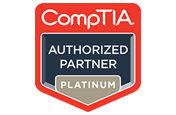We're open through the holidays to support your upskilling goals — Which training do you want to book?
We're open through the holidays to support your upskilling goals — Which training do you want to book?
Unable to find what you're searching for?
We're here to help you find itCompTIA Pentest+ ( PT0-002) Course Overview
The CompTIA PenTest+ (PT0-002) course is a comprehensive training program designed for cybersecurity professionals seeking to master penetration testing skills. It prepares learners for the PenTest+ certification, focusing on the latest techniques and methodologies used to assess and improve the security of IT systems.
Module 1: Planning and Scoping covers the essentials of Governance, Risk, Compliance, and the criticality of scoping, while emphasizing the Ethical mindset required in the field. Module 2: Information Gathering and Vulnerability Scanning delves into Reconnaissance methods and Vulnerability assessment. Module 3: Attacks and Exploits teaches how to perform a variety of attacks, including network, wireless, application, cloud, and Social engineering exploits. Module 4: Reporting and Communication addresses the creation of detailed reports and effective communication, which are key to the penetration testing process. Lastly, Module 5: Tools and Code analysis covers Scripting, Code analysis, and the Use of tools across different test phases.
By undergoing CompTIA PenTest training and earning the CompTIA PenTest+ certification, learners can validate their skills as proficient penetration testers, capable of identifying, exploiting, and reporting on vulnerabilities in various IT environments.
Successfully delivered 19 sessions for over 53 professionals
Purchase This Course
USD
View Fees Breakdown
| Course Fee | 2,950 |
| Exam Fee | 350 |
|
Total Fees (without exam) |
2,950 (USD) |
USD
View Fees Breakdown
| Course Fee | 2,250 |
| Exam Fee | 350 |
|
Total Fees (without exam) |
2,250 (USD) |
USD
View Fees Breakdown
| Flexi Video | 16,449 |
| Official E-coursebook | |
| Exam Voucher (optional) | |
| Hands-On-Labs2 | 4,159 |
| + GST 18% | 4,259 |
|
Total Fees (without exam & Labs) |
22,359 (INR) |
|
Total Fees (with Labs) |
28,359 (INR) |
Select Time
Select Date
| Day | Time |
|---|---|
|
to
|
to |
♱ Excluding VAT/GST
You can request classroom training in any city on any date by Requesting More Information
Inclusions in Koenig's Learning Stack may vary as per policies of OEMs
Scroll to view more course dates
You can request classroom training in any city on any date by Requesting More Information
♱ Excluding VAT/GST
*Inclusions in Koenig's Learning Stack may vary as per policies of OEMs
Suggestion submitted successfully.
Koenig Learning Stack
Inclusions in Koenig's Learning Stack may vary as per policies of OEMs



